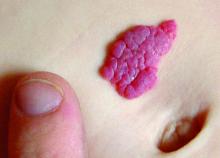CHICAGO – Among physicians using generic propranolol to treat infantile hemangioma, 30% reported at least one patient experienced a miscalculation dosing error, a new survey showed. Among respondents who prescribed Hemangeol (Pierre Fabre Pharmaceuticals), 10% reported a similar error. The errors were made by either a provider or caregiver.
Confusion may have contributed to a second source of errors, said Elaine Siegfried, MD, professor of pediatrics and dermatology at St. Louis University in Missouri. Generic propranolol is supplied as a 20-mg/5-mL oral solution and a 40-mg/5-mL oral solution. “Any time you have more than one formulation, it’s a nidus for dispensing error by the pharmacy.”
“That’s what I noticed. I make people bring in their medicines to check that, because I know dispensing errors are common,” Dr. Siegfried said in an interview following a presentation at the annual meeting of the American Academy of Pediatrics.“So if a doctor prescribes [the lower dose], which is what we always do for safety, and they get 40 [mg], the [patient] can become hypoglycemic, hypotensive, or bradycardic,” Dr. Siegfried said. “That’s not good.”
Dr. Siegfried and colleagues assessed survey responses from 223 physicians. The majority, 90%, reported prescribing generic propranolol to treat infantile hemangioma in the past. Sixty-percent reported also prescribing the brand name formulation approved by the Food and Drug Administration in 2014. Most of those who completed the survey, 70%, were pediatric dermatologists; general dermatologists, pediatric otolaryngologists, and other specialists also participated.
A total of 18% of physicians surveyed reported a dispensing error associated with use of generic propranolol. Dr. Siegfried said such errors are not possible with the branded formulation because it is available only in a single concentration, a 4.28 mg/mL oral solution. She added that one central specialty pharmacy dispenses Hemangeol, further reducing the likelihood of errors.
Addressing cost concerns
“When this [branded] drug became available, I wondered why everyone was not prescribing it,” Dr. Siegfried said.
“One of the pushbacks with this drug is that people didn’t want to prescribe it because they thought it was too expensive.” She acknowledged the higher cost, but added the manufacturer has a program to provide the agent free-of-charge to families without health insurance who cannot afford the medicine. She added, “People with private insurance do have higher copays, but insurance generally pays for most of it, depending on the plan.”
Dr. Siegfried also emphasized that the manufacturer invested considerable time and money to bring the agent and its specific pediatric indication to market, generating scientific data on its safety and efficacy along the way. In contrast, generic propranolol has been available in the United States for decades as a beta-blocker. The discovery that the agent also could effectively treat infantile hemangioma was serendipitous, not based on preclinical efficacy, safety, or dosing studies.
An additional benefit of the single-concentration branded formulation is pediatric clinicians might be more comfortable using this agent, Dr. Siegfried said. She described the package insert instructions as straightforward and easy to follow. Also, given a sometimes longer wait to see a pediatric dermatologist because of their shortage in certain parts of the country, having general pediatricians or family physicians gain proficiency in administering the medication could mean earlier treatment of hemangioma. “If you have to wait to get into a specialist, that can delay treatment. The caveat about hemangiomas is the earlier you treat them, the more effective the treatment is.”
“Using propranolol to treat hemangiomas is probably one of the biggest positive changes in my practice. It was very difficult to treat hemangiomas with steroids, vincristine, or other alternatives. Now treatment is ‘cookbook’ and well-tolerated. It’s amazing,” Dr. Siegfried said. “I only prescribe the branded propranolol because of the specialty pharmacy issue, because of the formulation issue, and because we have data that Pierre Fabre paid for,” she added.
Dr. Siegfried is a consultant for Pierre Fabre and served as a principle investigator on phase 3 research. The company did not sponsor the current study, but a coauthor and employee of Pierre Fabre assisted with the logistics of the survey.



